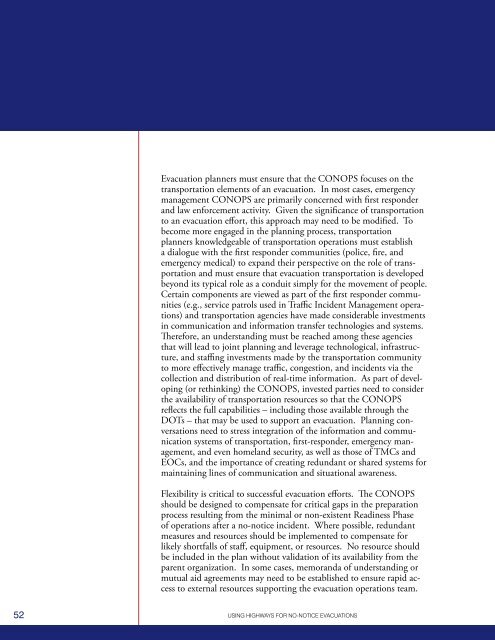using highways for no-notice evacuations - FHWA Operations - U.S. ...
using highways for no-notice evacuations - FHWA Operations - U.S. ...
using highways for no-notice evacuations - FHWA Operations - U.S. ...
You also want an ePaper? Increase the reach of your titles
YUMPU automatically turns print PDFs into web optimized ePapers that Google loves.
Evacuation planners must ensure that the CONOPS focuses on thetransportation elements of an evacuation. In most cases, emergencymanagement CONOPS are primarily concerned with first responderand law en<strong>for</strong>cement activity. Given the significance of transportationto an evacuation ef<strong>for</strong>t, this approach may need to be modified. Tobecome more engaged in the planning process, transportationplanners k<strong>no</strong>wledgeable of transportation operations must establisha dialogue with the first responder communities (police, fire, andemergency medical) to expand their perspective on the role of transportationand must ensure that evacuation transportation is developedbeyond its typical role as a conduit simply <strong>for</strong> the movement of people.Certain components are viewed as part of the first responder communities(e.g., service patrols used in Traffic Incident Management operations)and transportation agencies have made considerable investmentsin communication and in<strong>for</strong>mation transfer tech<strong>no</strong>logies and systems.There<strong>for</strong>e, an understanding must be reached among these agenciesthat will lead to joint planning and leverage tech<strong>no</strong>logical, infrastructure,and staffing investments made by the transportation communityto more effectively manage traffic, congestion, and incidents via thecollection and distribution of real-time in<strong>for</strong>mation. As part of developing(or rethinking) the CONOPS, invested parties need to considerthe availability of transportation resources so that the CONOPSreflects the full capabilities – including those available through theDOTs – that may be used to support an evacuation. Planning conversationsneed to stress integration of the in<strong>for</strong>mation and communicationsystems of transportation, first-responder, emergency management,and even homeland security, as well as those of TMCs andEOCs, and the importance of creating redundant or shared systems <strong>for</strong>maintaining lines of communication and situational awareness.Flexibility is critical to successful evacuation ef<strong>for</strong>ts. The CONOPSshould be designed to compensate <strong>for</strong> critical gaps in the preparationprocess resulting from the minimal or <strong>no</strong>n-existent Readiness Phaseof operations after a <strong>no</strong>-<strong>no</strong>tice incident. Where possible, redundantmeasures and resources should be implemented to compensate <strong>for</strong>likely shortfalls of staff, equipment, or resources. No resource shouldbe included in the plan without validation of its availability from theparent organization. In some cases, memoranda of understanding ormutual aid agreements may need to be established to ensure rapid accessto external resources supporting the evacuation operations team.52 USING HIGHWAYS FOR NO-NOTICE EVACUATIONS
















